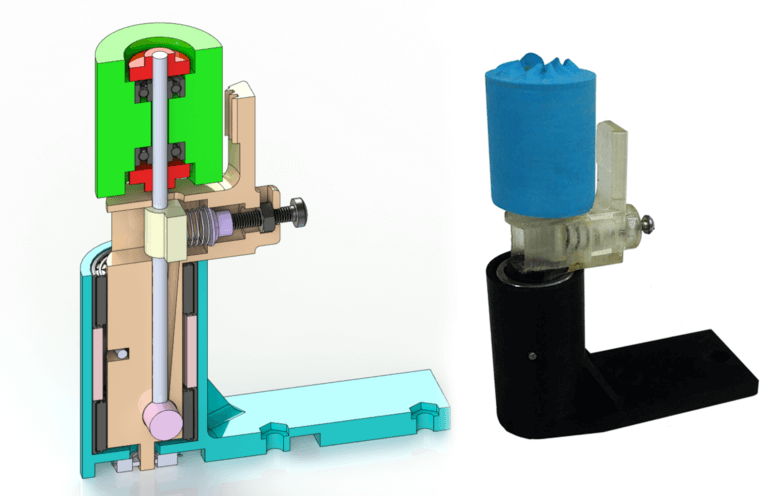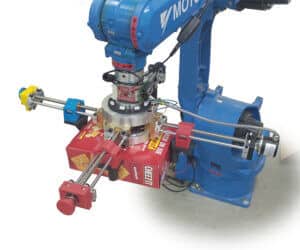Minimalist robotic grips - design, algorithms, and control of grip systems

Industrial robots, which are gradually replacing humans, are used in principle to perform dangerous or repetitive tasks - especially tasks that require a high degree of precision. One of the features required of industrial robots is the ability to grasp objects whose shape and other properties are not known in advance. This is the challenge at the center of research by Prof. Amir Shapira from the Department of Mechanical Engineering at Ben-Gurion University in the Negev, and Prof. Ilon Rimon from the Faculty of Mechanical Engineering at the Technion in Haifa, and whose participants include Yoav Golan from Ben-Gurion University and Hillel Bonis from the Technion.
When we pick up a pen that has fallen on the floor or hold a glass of water, we do not think about the complexity inherent in these seemingly simple actions, but it is not a simple task to design a robotic hand that will perform these tasks simply and efficiently. The human hand holding a certain object activates more than 30 muscles, and in order to design a robotic hand that will accurately imitate the way our hand works, a motor is needed for each muscle. Technion and Ben Gurion University of the Negev scientists aim to develop an efficient, cheap and convenient robotic hand for industrial use as possible, in a minimalist high school - using only one motor.
It turns out that a simple hand, with only two fingers that can open and close, can grasp a very wide variety of objects, but it is necessary to find out exactly where these fingers should be placed on an object whose shape is not known in advance, so that it is grasped effectively and does not cause damage. This research has two aspects: a mechanical aspect and an algorithmic aspect.
In terms of the mechanical side, the study includes two innovations. The first of these is a secondary of fingers that can alternate between a frictionless grip and a friction grip. Thanks to a spring-loaded locking mechanism inside each finger, which is cylindrical in shape, the hand can grasp any bone in two ways: without friction, that is, without force acting between the fingers and the body, and when necessary - when the locking mechanism is activated - the grip is strong and involves friction. This mechanism prevents "sticking" of the bone when trying to grasp it and improves the quality of the grip. The second mechanical innovation allows the robotic hand to be satisfied with only one motor, thanks to its ability to change its shape with the help of the environment, even before the grip itself. It is actually about adding another step to the grasping process, a step that takes place before touching the object, in the framework of which it is possible to change - with the help of pressing the hand against the wall, for example - various properties of the fingers (for example, their angles and their distance from the middle) in a way that will allow them to grasp any object. The research team developed a method for quickly and efficiently performing this additional preparation step. The algorithmic aspect is related to the aspiration to grasp the bone in the most efficient way, by encircling it between the fingers and creating a sort of cage around it.
The algorithmic aspect is related to the aspiration to grasp the bone in the most efficient way, by encircling it between the fingers and creating a sort of cage around it. The purpose of the algorithms is to determine where we should place our fingers around the bone,

depending on its geometry, so that on the one hand it will not be crushed, and on the other hand it will not fall from the robotic hand. For this purpose it is important to know all the possible movements that the object may make in space and all the possibilities of the fingers to block these movements, as a function of their exact positions on it.
To this end, the research team developed a graphical search method that would allow identifying the points where the fingers should be positioned, in order to obtain a successful cage grip and predict what will happen after the fingers are closed. One of the goals was to find the contact points with the maximum distance between the fingers that does not allow the bone to escape: the greater the distance, the greater the error in the initial grasping of the bone by the robotic hand. Computer simulations demonstrate the operation of these algorithms on bodies of various shapes, and in the end the algorithms and the mechanical system are tested in real experiments. In the experiments conducted so far - with the help of a research grant from the National Science Foundation - the robotic hand was able to grasp a wide variety of bodies, in a satisfactory manner. The interim results of the study indicate that a multi-motor hand is not needed to achieve a complex and safe grip, and that it is possible to be satisfied with a simpler system that relies on a correct algorithm to perform quality grips.
More of the topic in Hayadan:
- Controlled capture of biological micro-objects with the help of a laser
- "Our robots can cook 10,000 different recipes in restaurant quality and with natural ingredients"
- A robot with 'hands' and augmented reality glasses will improve the accuracy in spine surgeries
- "The workers on the production lines are getting old, only robots will be able to replace them"
